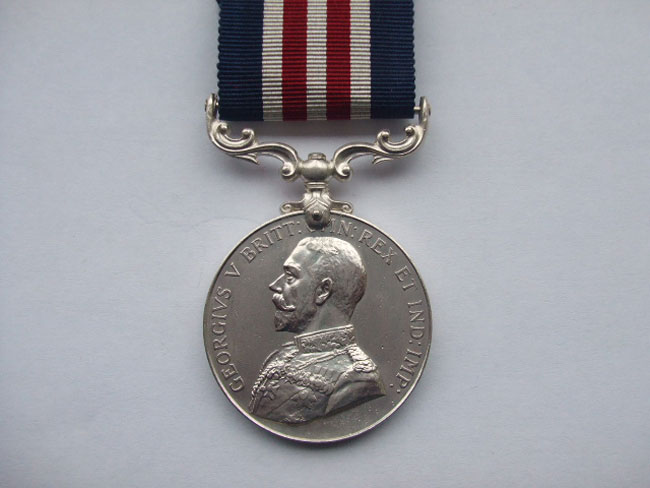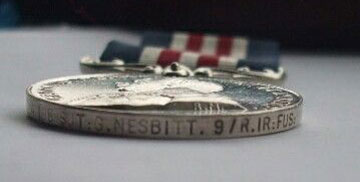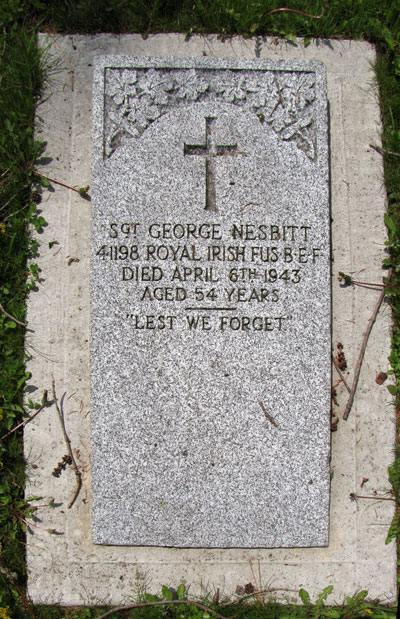Sergeant George Nesbitt, MM
George Nesbitt was born at Tyrarden, Ballybay, County Monaghan, on 15 May 1886, the eleventh of thirteen children of farmer Joseph Nesbitt and his wife Mary Anne (née Hollinger). At the time of the 1901 Census he was living at Tirarden with his parents and three of his siblings. His father died there five years later.
Nesbitt enlisted in the North Irish Horse on 12 October 1908 (No.223), just months after the regiment was established.
In October 1910 he travelled to the United States where, on 3 October the following year he married Sarah Jane Blackstock at Dover, Strafford, New Hampshire. (She may have been the Sarah Jane Blackstock born at Aghnameal, County Monaghan on 8 February 1883, who appears to have emigrated to the United States in September 1910.) George returned to Tyrarden with his wife two months later. Their first child, Annie Elizabeth, was born on 17 April 1912 and their second, William George, on 16 April 1913. Unfortunately Sarah Jane died while giving birth to him.
Nesbitt embarked for France with A Squadron on 17 August 1914, seeing action in the retreat from Mons and advance to the Aisne. A Squadron then served as escort and bodyguard to the BEF's commander-in-chief at St Omer from October 1914 until January 1916, when it was posted as divisional cavalry to the 55th Division. In May 1916 A, D and E Squadrons of the North Irish Horse came together to form the 1st North Irish Horse Regiment. C and F Squadrons, together with the 6th (Inniskilling) Dragoons Service Squadron, became the 2nd North Irish Horse Regiment.
In August-September 1917 the 2nd NIH Regiment was disbanded and its men, together with some surplus to the needs of the 1st NIH Regiment, were transferred to the Royal Irish Fusiliers, an infantry regiment. Most, including Nesbitt, were transferred on 20 September and posted to the 9th (Service) Battalion – renamed the 9th (North Irish Horse) Battalion – joining it in the field at Ruyaulcourt soon after. Nesbitt was issued regimental number 41198 and posted to D Company.
He probably saw action with the battalion at the Battle of Cambrai in November and December 1917.
Nesbitt was one of the many wounded during the 9th (NIH) Battalion's fighting withdrawal from St Quentin from 21 to 28 March 1918 during the German spring offensive. The extent of the injury is not clear, but a later newspaper report (see below) stated he had been wounded in April. This may have been a second injury, occurring during the fighting between Wulverghem and Kemmel on the Ypres front from 11 to 18 April 1918, or simply a misreporting of the timing of the first. Either way the wound, to the abdomen, was serious, and Nesbitt was evacuated to the UK for treatment.
In June 1918 it was announced that he had been awarded a Military Medal. This most probably would have been for his action in March or April. On 15 June 1918 The Larne Times and Weekly Telegraph reported that:
Sergeant George Nesbitt, Royal Irish Fusiliers, who ... has been awarded the Military Medal, is a son of Mrs. Nesbitt, Tyrardon, Ballybay. He was formerly in the North Irish Horse, and went to France in 1914. He was wounded last April. Sergt. Nesbitt's brother is also serving in the forces."
Nesbitt was discharged from the army on 28 November 1918 due to his wounds, being 'no longer physically fit for war service' (paragraph 392(xvi), King's Regulations). He was awarded a pension, his level of disability assessed at 40 per cent in November 1919. (This had improved to 20% by October 1922, when his pension was made permanent.)
At some point after the war Nesbitt emigrated to North America. He died there on 6 April 1943. There is a memorial to his memory in the Ballybay Second Presbyterian churchyard (see below).
One of Nesbitt's brothers, William Nesbitt, also served in the war, in the North Irish Horse and the Labour Corps.


Nesbitt's Military Medal

Ballybay Second Presbyterian Churchyard
Memorial image sourced from the Find a Grave website.
This page last updated 6 November 2023.
